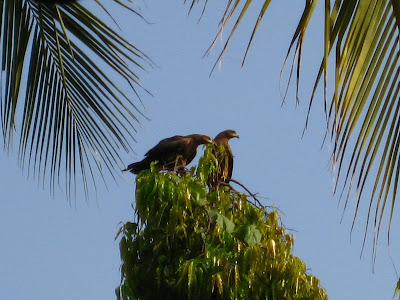 Be honest... would you like to see this barrelling towards you at full tilt on a lonely road?
Be honest... would you like to see this barrelling towards you at full tilt on a lonely road?It looked menacing, waving two pointy tentacles at me (loaded with poison, I'm sure! ). There were even more tentacles, all tightly rolled up . A mask that Batman would've loved, slashed across its face and it just kept marching full speed at me.
Didnt it know fear? After all, I'm about a zillion times its size and could squish it to a very messy pulp. Aaah... but there were those tentacles .... extra-long, pointy and bright red at the tip. Just like the poison arrows of all those Amazonian tribes that I've seen in every encyclopaedia in the library !

She just kept going round and round the same pot. Maybe she had lost her way and didn't want to admit it.
But I've got to admit that her tentacles still have me worried!
After a lot of research (thanks Wiki!) I found that I was absolutely right to be worried about her. Or rather, I should have been if I were a bird or other predator.
Apparently this caterpillar of the Common Crow butterfly prefers munching on plants like Nerium oleander, Ficus and others with poisonous latex in them. These toxins are stored in its body and later, even in its adult stage, the toxins make it totally inedible and persona non grata among the predators.
Clever! They're more or less the butterfly equivalent of the infamous Vish-kanyas!

Who are Vish-kanyas? They are literally the 'Poison-girls' (vish = poison, kanya = girl). Indian legends go into graphic detail about girls (almost always beautiful and seductive ... obviously!) who were fed small doses of poison every day until a mere touch or kiss from them was enough to kill.
Stories abound of Chanakya, the very clever and shrewd prime minister (he could've taught Machiavelli a thing or two!) of King Chandragupta, who used these Vish-kanyas to get rid of their enemies.
On the internet I even found a claim that Chandragupta had sent some of these seductive Vish-kanyas to Alexander the Great when he invaded India. Whether it was to aid him or to kill him was not clear.
Then again, I found it on the Net so I'm not too sure ... maybe a cupful of salt is called for here, unless some of my more knowledgeable readers can tell me different?

But coming back to the Common Crow butterfly, it is so confident about its immunity from attack that it has a very slow, lazy flight. Which makes it one of the most easily photographed butterflies in my garden.
Just one thing bewilders me ... what on earth made them call this butterfly a Crow ? Can you see any resemblance at all to the bird in the photo below?












































